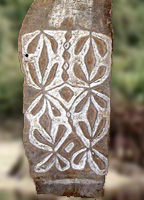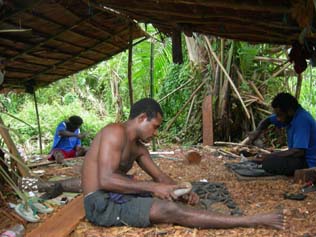Asmat Carvers: Jayapura, Papua
 In the Papua province of Indonesia is an ethnic group known as the Asmat. They are renowned for their vibrant woodcarving traditions and their art is sought by collectors worldwide.
In the Papua province of Indonesia is an ethnic group known as the Asmat. They are renowned for their vibrant woodcarving traditions and their art is sought by collectors worldwide.
The Asmat inhabit a region on the island’s southwestern coast, totaling approximately 19,000 square kilometres consisting of mangrove, tidal swamp, freshwater swamp, and lowland rainforest.
I was pleased to read an article by Nethy Dharma Somba yesterday about a group of Asmat students who are utilising their skills as Asmat carvers to fund their education:
Asmat carvings fuel education
Nethy Dharma Somba, Jayapura
The price of an Asmat wood carving can vary dramatically depending on circumstances.
An Asmat woodcarving can fetch tens of millions of rupiah during auctions held at the annual Asmat Cultural Festival. Purchasers are usually foreign collectors and tourists.
However, Asmat students studying in Jayapura need money to finance their studies and often sell pieces for as low as Rp 30,000 (US$3.30).
Fifteen Asmat students staying in Waena have built a modest hut on a plot of land owned by a Toraja resident, functioning as accommodation as well as a workshop to produce carvings.

They usually carve pieces of art in the afternoon after returning from campus. Their work area has a clay floor and a thatched roof.
“This hut has produced 50 graduates from the profits of selling wood carvings,” said Tinus Ir, a final-year law student at the Unmel Mandiri Institute in Jayapura.
Tinus lives with 14 other students in the hut which has not had electricity since it was built in 1999. The stilt hut consists of three bedrooms with walls made of sago trunks. The kitchen is located at the rear of the hut.
The students use kerosene lamps or candles to study at night.
They realize that when funds run low, the time has come to sell their carvings at cheap prices. “It is better to sell our work cheap rather than not have money to eat or for transportation to campus,” said Kaletus Paulus Sein, who recently completed his studies at the Law School at the same university.
Students usually charge between Rp 200,000 and Rp 350,000 per carving to art traders at the Hamadi market in Jayapura, who later sell them to tourists for at least Rp 500,000.
The students buy materials such as wooden panels and beams for Rp 350,000 per cubic meter, which is enough to make between 10 and 20 items depending on size.
The wood carvings produced by the students are of a high quality and are as good as those crafted by their parents.
The students are generally self-taught in the art. “I used to watch my father produce wood carvings when I was young and I acquired the skill naturally,” said Kaletus.
Tinus acquired the skill after becoming a student. However, his products are still of a high quality. “I learned the skill when I started university and I am able to sell my works now,” he said.
The art of Asmat wood carving has become a tradition and a necessity for many Asmat students paying for their own studies in Jayapura.
They can produce dozens of carvings each month. It is unfortunate that many pieces are sold at low prices considering the world-renowned status of Asmat carvings. However, for the sake of their studies, the students see this as no big deal.
“One day we hope to open an art shop or gallery to exhibit the works of Asmat students so that tourists will no longer buy carvings from second or third parties but directly from us,” said Kaletus.